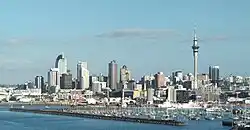
New Zealand is a remote island nation in the South Pacific with a history shaped by Maori colonization, European exploration, and eventual self-governance. Believed to have been discovered by Polynesian explorer Kupe in the 14th century, the islands were charted by a Dutch explorer in the 17th century. British influence grew in the 19th century, and gradual growth, fueled by Scottish migration and gold discovery, led to conflicts with Maori groups. New Zealand gained increasing autonomy, becoming fully independent in 1947 while retaining ties to the British Commonwealth. Its diverse geography ranges from the Southern Alps to strategic coastal cities like Auckland and Wellington. Archival records and consistent census-taking illuminate the nation's historical and demographic evolution.
Research your ancestors on MyHeritage
The regions of New ZealandThe regions of New Zealand
New Zealand is divided into 16 regions:
New Zealand historyNew Zealand history

The islands which make up the New Zealand archipelago were uninhabited for much of human history, in large part because of their geographical remoteness from the world’s main continents. They were allegedly discovered in the fourteenth century by Kupe, a semi-legendary Polynesian explorer. Thereafter the Maori people colonized the islands. They predominated there for the next half a millennium, though there were some brief interruptions to their isolation here. For instance, in 1642 and 1643, the Dutch explorer, Abel Tasman, who had also explored the southern coast of Australia and the island of Tasmania, which is named after him, charted the coastline of the North Island, though without ever making landfall.[1] A Dutch cartographer subsequently named the region Nieuw Zeeland, because the many inlets and riverine route-ways along its coast which Tasman had explored reminded him of Zeeland in the Netherlands. It would be another century and a quarter before a European expedition, this one led by James Cook in 1769, arrived to the region, anglicizing the Dutch name for it as New Zealand in the process.[2]
The British colony in New Zealand developed quite slowly in the first thirty or so years of the nineteenth century, largely as an unplanned offshoot of the bigger British colonies in Australia and Van Diemen’s Land (Tasmania). It was only in the 1830s that a British governor was appointed when James Busby arrived as British Resident. In 1840 the Treaty of Waitangi was signed between the British government and hundreds of Maori chiefs, effectively affirming Maori ownership of their lands in return for becoming British subjects more broadly. This was all intended to stall efforts by the French and other powers from establishing whaling and fishing bases on the islands.[3]
From the 1840s onwards the settler population grew extensively, with many younger people arriving to the islands from Scotland in particular. This growth expanded further after the discovery of gold at Gabriel’s Gully in Otago on the South Island in 1861. By the end of the nineteenth century there were hundreds of thousands of people of European extraction on the islands, though the growth of the colony had led to extensive wars between the colonists and some Maori groups, though this also had the characteristic of being a partial civil war, as some Maori groups fought with the Europeans.[4]
New Zealand did not achieve independence at any one time. In 1857 it was granted a considerable degree of self-governance, a necessity in a country which was so isolated at the time and which could not report to Britain for directions on every little matter. In 1907 the status of the country was changed from the ‘Colony of New Zealand’ to the ‘Dominion of New Zealand’. Thereafter New Zealand was effectively independent in terms of its domestic affairs, but Britain retained control over its foreign policy. It was not until 1947, when the New Zealand parliament ratified the Statute of Westminster, which had been passed in 1931 in Britain, that New Zealand acquired full independence, though it remains a member of the British Commonwealth of Nations.[5]
New Zealand geographyNew Zealand geography
New Zealand is an island archipelago in the South Pacific, one which is relatively isolated from much of the world’s main continents, south-eastern Australia being approximately 2,500 kilometers from it. The island chain consists of two main islands, somewhat unimaginatively called the North Island and South Island, while there are a number of smaller islands and islands chains such as Stewart Island, Campbell Island and the Chatham Islands.[6]

Roughly three-quarters of the population of just over five million people live on the North Island, with Auckland being the most populous city with upwards of 1.7 million inhabitants in its wider metropolitan area. The capital Wellington is significantly smaller, with just over half a million people in the metro area, but it does occupy a strategic geographical location at the southern point of the North Island and so is centrally located in the archipelago. The biggest city on the South Island and the third largest in the country overall is Christchurch with about 390,000 people. This population disparity is explained by the South Island being much more mountainous, dominated by the Southern Alps.[7]
Family history and genealogical studies in New ZealandFamily history and genealogical studies in New Zealand
Because it was first founded as a nation state through British colonization, many records for New Zealand’s early colonial history in the nineteenth century are actually located in British archives in London today, notably amongst the colonial series of records in the National Archives of the UK in Kew in London.[8] At home, the best repository for the study of family history and genealogy is Archives New Zealand, which is based in Wellington.[9] The first census carried out here was undertaken in 1851, but this only enumerated the colonial population of European descent and made no effort to count the Maori people. Censuses have been held ever since then with impressive regularity, generally being carried out every five years since 1877, with only a few exceptions.[10]
Ethnicities in New ZealandEthnicities in New Zealand
New Zealand is characterized by its ethnically diverse population. The major ethnic groups include New Zealand Europeans, Maori, Pacific Islanders, Asians, and smaller minority communities. The indigenous Maori people hold a significant cultural and historical position, acknowledged through the Treaty of Waitangi. This multicultural composition has shaped various aspects of the country, including policies, languages, and traditions, fostering a dynamic and inclusive society.
Surnames in New ZealandSurnames in New Zealand
Surnames in New Zealand showcase its multicultural heritage. European-origin surnames, often from British origins, such as Smith, Brown, and Wilson are common due to colonization. Maori surnames, such as Harawira, Ngata, and Waititi, carry ancestral significance, with many referring to landmarks or tribal affiliations. Increasingly, immigrants' surnames reflect the nation's diversity, including Chinese, Indian, and Pacific Islander origins. This amalgamation highlights New Zealand's cultural fusion, where traditional names interweave with those from different corners of the world.
See alsoSee also
- New Zealand genealogy
- New Zealand immigration
- New Zealand emigration
- New Zealand archives
- Vital records in New Zealand
- Birth records in New Zealand
- Death records in New Zealand
- Marriage records in New Zealand
- Census records in New Zealand
- Civil registrations in New Zealand
- Church records in New Zealand
- Newspaper records in New Zealand
- Military records in New Zealand
- Polynesian ethnicity
- English ethnicity
- Irish, Scottish, and Welsh ethnicity
- North and West European ethnicity
- New Zealand surnames
- Māori surnames
- British colonization of New Zealand
Explore more about New ZealandExplore more about New Zealand
- All historical record collections from New Zealand on MyHeritage
- Researching Your New Zealand Ancestors, webinar by Jan Gow on Legacy Family Tree Webinars
- Finding Families in New Zealand, webinar by Fiona Brooker on Legacy Family Tree Webinars
- All webinars on researching ancestors from New Zealand on Legacy Family Tree Webinars
References
- ↑ https://nzhistory.govt.nz/people/abel-tasman
- ↑ https://www.theguardian.com/world/2022/aug/11/aotearoa-or-new-zealand-has-the-moment-come-to-change-the-countrys-name
- ↑ https://nzhistory.govt.nz/politics/treaty/the-treaty-in-brief
- ↑ https://teara.govt.nz/en/new-zealand-wars
- ↑ https://www.parliament.nz/en/pb/research-papers/document/00PLLawRP07041/new-zealand-sovereignty-1857-1907-1947-or-1987
- ↑ https://www.countryreports.org/country/NewZealand/geography.htm
- ↑ https://nzpocketguide.com/the-10-biggest-cities-in-new-zealand/
- ↑ https://discovery.nationalarchives.gov.uk/details/r/C4400
- ↑ https://www.archives.govt.nz/
- ↑ https://www.stats.govt.nz/reports/introduction-to-the-new-zealand-census

